- World
- Mar 23
Luis Caffarelli wins Abel Prize for maths
• The Abel Prize for mathematics was awarded to Argentine-American Luis Caffarelli.
• A professor at the University of Texas, Caffarelli, 74, was honoured for his works on non-linear partial differential equations, including free-boundary problems and the Monge–Ampère equation.
• This type of equation models how several variables change with respect to each other, and play a prominent role in many disciplines, including engineering, physics, economics and biology.
• Norway’s King Harald V will present the Abel Prize to Caffarelli at an award ceremony in Oslo on May 23.
• Last year, the Prize was won by US mathematician Dennis Sullivan for his research into topology and chaos theory.
What is Abel Prize?
• The Abel Prize is named in honour of the Norwegian mathematician Niels Henrik Abel (1802-1829). The Abel Prize was established by the Norwegian Parliament (The Storting) in 2002, on the occasion of the 200-year anniversary of Abel’s birth.
The Prize is awarded annually by the Norwegian Academy of Science and Letters on behalf of the Norwegian government.
• The Prize is 7.5 million Norwegian Kroner. It is awarded by The Norwegian Academy of Science and Letters.
• The Abel Committee, consisting of five leading mathematicians from throughout the world, holds the task of appraising nominated candidates and recommending a worthy winner.
• The main purpose of the Abel Prize is to acknowledge groundbreaking scientific achievements within the discipline of mathematics. In addition to celebrating exceptional mathematicians and their work, the intent of the Abel Prize is also to increase the status of mathematics in general.
Caffarelli introduced ingenious new techniques
• Differential equations are tools scientists use to predict the behaviour of the physical world. These equations relate one or more unknown functions and their derivatives. The functions generally represent physical quantities, the derivatives represent their rates of change, and the differential equation defines a relationship between the two.
• Such relations are common. Therefore, differential equations play a prominent role in many disciplines including engineering, physics, economics, and biology.
• Partial differential equations arise naturally as laws of nature, to describe phenomena as different as the flow of water or the growth of populations. These equations have been a constant source of intense study since the days of Isaac Newton and Gottfried Leibniz.
• Yet, despite substantial efforts by numerous mathematicians over centuries, fundamental questions concerning the existence, uniqueness, regularity, and stability of solutions of some of the key equations remain unresolved.
• Few other living mathematicians have contributed more to our understanding of partial differential equations than Luis Caffarelli. He has introduced ingenious new techniques, shown brilliant geometric insight, and produced many seminal results.
• Over a period of more than 40 years, he has made groundbreaking contributions to regularity theory. Regularity – or smoothness – of solutions is essential in numerical computations, and absence of regularity is a measure of how wildly nature can behave.
• Caffarelli has won numerous awards, among them the Leroy P. Steele Prize for Lifetime Achievement in Mathematics, the Wolf Prize and the Shaw Prize.
Manorama Yearbook app is now available on Google Play Store and iOS App Store

